As soon as you begin your search for a basketball hoop, you’ll soon realize there is no shortage of brands and models available. Whether you’re a first time buyer or or looking to replace an existing system, here are some key factors to keep in mind when buying a basketball hoop:
Installation Type
This one of the primary factors to consider when purchasing a basketball hoop. There are 4 main basketball goal installation types.
Portable
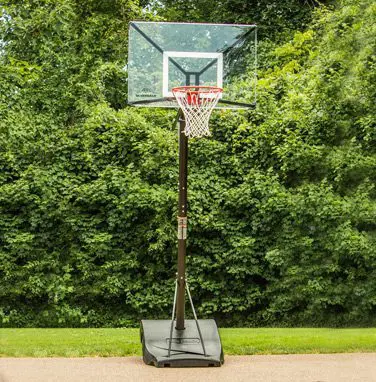
Portable basketball hoops are generally cheaper and smaller than hoops that are cemented into the ground. These goals include a base that is stabilized with either water or sand. Because of this, these goals CANNOT be dunked on. Additionally, they may be at risk of damage from garbage collectors as well. They are, however, a great solution for situations where mounting a goal in-ground simply isn’t possible (rental properties, for example).
Wall-Mount
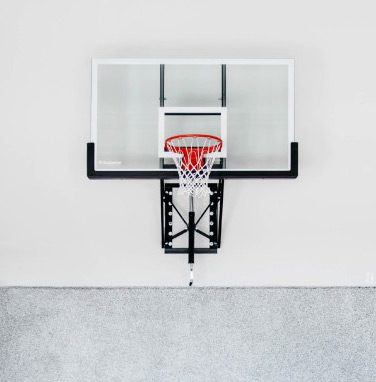
Wall-mounted hoops are mounted to, you guess it- the wall. This type of hoop works well when space doesn’t allow for an in-ground goal. They should be installed by a qualified professional to ensure safety and structural integrity of the wall to which it is being mounted. If the goal is indoors, consider also adding wall-padding for player safety. Wall mounts usually come in an adjustable version that allows you to change heights and fixed that keeps the hoop affixed and rigid.
Direct Burial (Permanent) In-Ground
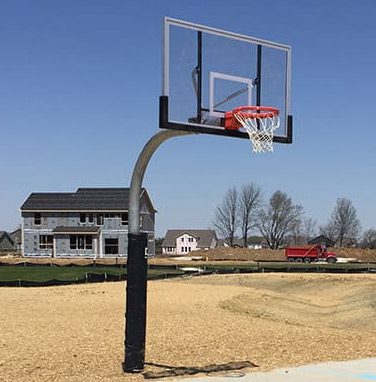
Basketball hoops with the post cemented directly into the ground are known as direct-burial in-ground hoops. The goals provide much more stability than portable goals. The drawback to this type of goal is that it cannot be moved once it is installed. This type of goal is most commonly found in commercial applications such as parks, where height adjustment isn’t needed.
In-Ground Semi Portable
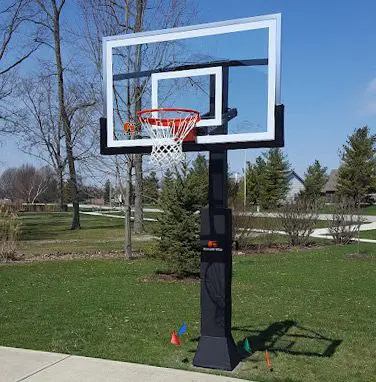
Semi-portable in-ground goals, on the other hand, are mounted onto a completely separate anchor system that is cemented into the ground. This provides the same stability of a direct-burial post while still allowing the goal to be moved to a new location (if you move to a new home, for example). Then, only a new anchor kit is needed, rather than an entirely new basketball system. Goalrilla and Goalsetter goals feature this type of installation. Most residential high end hoops have moved to this system for both ease of installation and portability when moving.
The Backboard
Backboard Size
The size of the backboard is another important factor to consider when buying a basketball hoop. The most common sizes you’ll find are 54”, 60”, and 72”. This refers to the width of the backboard. The heights will vary also, depending on the model.
Regulation backboard size is 72”x42”. If you are purchasing a hoop for an aspiring high school or college athlete, or if you just want the most authentic, arena-like experience, the 72”x42” is the way to go. If you don’t need a goal quite that big, the 60” hoops are great mid-size hoops and the most popular choice for residential use. 54” goals are more common for smaller driveways that don’t have as much space to accommodate a larger hoop. For more info on finding a backboard size that fits your space, check out What Size Backboard Do I Need?
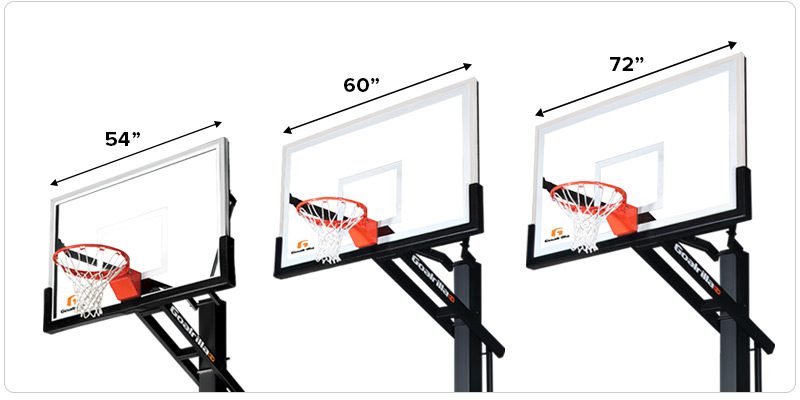
Backboard Material
Along with backboard size, you’ll want to consider backboard material. You’ll typically find basketball hoop backboards in one of 3 materials: Polycarbonate, Acrylic, or Tempered Glass
Polycarbonate backboards are made from a clear plastic material. They are often used on cheaper hoops because while they are very strong, the polycarbonate material has one major drawback; after prolonged exposure to UV light (aka sunlight), these backboards begin to turn an unflattering shade of cloudy yellow and become brittle. This can happen in as little as 3-5 years.
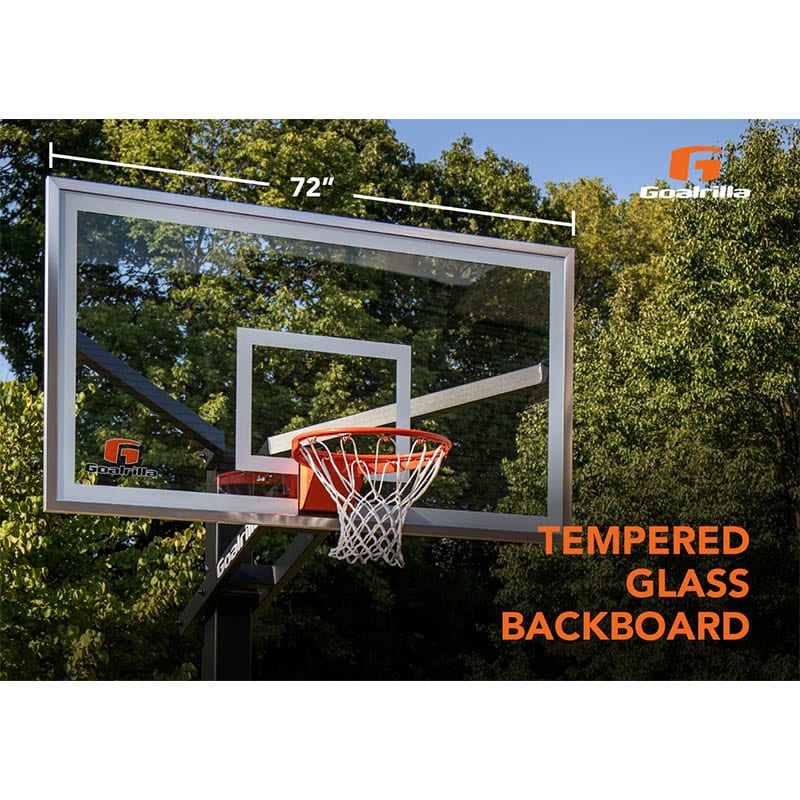
Acrylic is similar to polycarbonate in that it is a strong, clear backboard material. Unlike polycarbonate, however, acrylic will not become cloudy, yellow, and brittle over time. Acrylic maintains its brilliance after 15-20 years of sun exposure. It’s also very strong and unlikely to chip or crack, even if someone were to throw stones at it.
Tempered glass backboards are what you’ll find on pro-style hoops and in high school, college, and NBA arenas. The backboards are made from a safety glass that is hardened in the production process, making it 5-10 times stronger than normal glass. Tempered glass provides the most rigidity and better, more consistent rebounding across the glass.
For more a detailed analysis, check out Tempered Glass Backboards VS. Acrylic Backboards.
The Rim
Rim Material
The rim of the basketball goal should be made of steel to ensure strength and stability. The rim should be at least 19mm thick. Thinner rims may seem more cost-effective initially, but are prone to bending and even breaking over time. This means a lower quality rim could also pose a safety hazard. For outdoor hoops, we recommend a rim that is finished with a weatherproof paint to reduce the risk of rust.
Rim Suspension
In addition to rim material, you’ll also want to pay attention to the spring or suspension system of the rim when buying a basketball hoop. There are 3 basic types of rims: Static (or standard), Exposed Spring Breakaway, and Enclosed Spring Breakaway.
Static or standard rims have no spring, meaning the rim cannot flex. This puts added pressure on the backboard and is not ideal for dunking since the extra pressure can cause the backboard to shatter. The cheaper version of these rims are typically found on portable basketball goals which are not meant to be dunked on. Sometimes they are found on higher end goals, for example a commercial application where they are looking to deter dunking. Goalsetter even offers a double ring static rim that is considered extremely durable for commercial applications.
A breakaway rim, on the other hand, contains a hinge and a super strong spring (or springs) at the point of attachment to the backboard. This allows the rim to bend downward and then snap back into place when a player dunks on the goal without affecting the backboard. Exposed spring breakaway rims are open underneath with the springs exposed (hence the name). This is not preferred for outdoor use since exposure can lead to rust. Goalrilla carries both a medium weight and heavy weight flex rim.
Enclosed spring breakaway rims have the spring fully enclosed, making it the ideal choice for longevity of outdoor use. This is the type of rim found on pro-level hoops, and is what you’ll find on every Goalrilla goal.
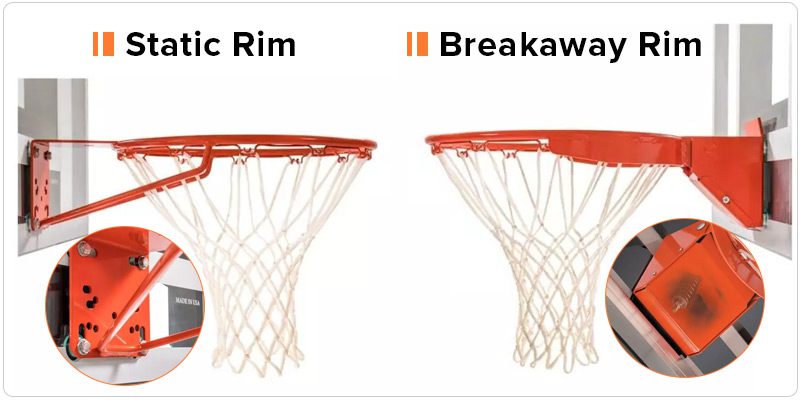
Net Material
The net attached to the rim serves two primary functions. It provides a clear indication to players, referees, and spectators when a basket is made. It also slows the ball’s trajectory as it passes through the hoop and guides it back down toward the court (ideally straight underneath the rim).
Basketball nets can be found in a variety of materials. For outdoor play, we recommend a nylon net because they are incredibly durable and made to withstand the harsh weather elements of snow, rain, and wind.
Height Adjustability
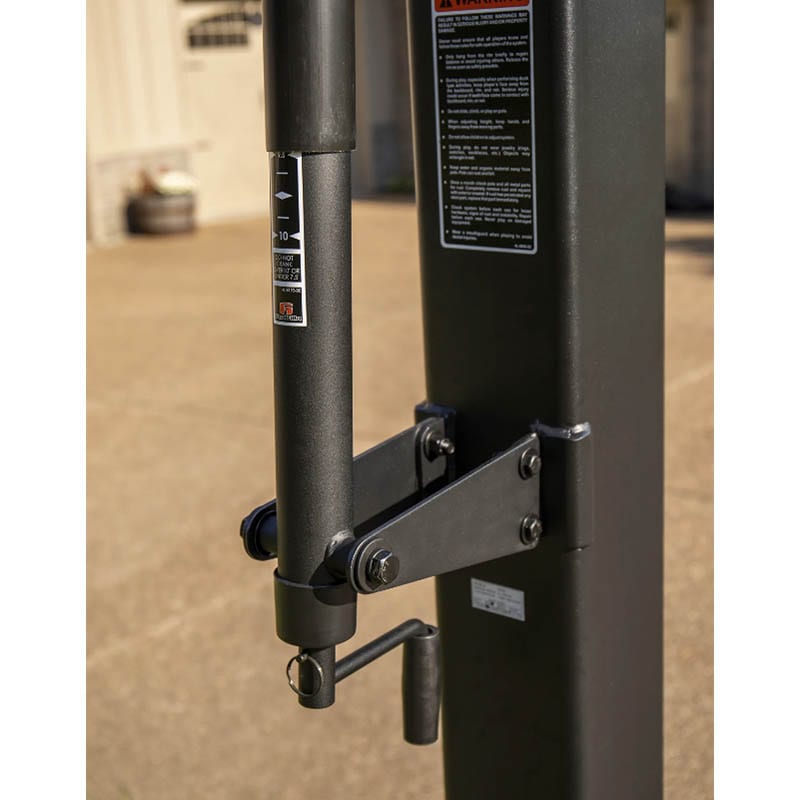
Height adjustability is an important consideration, particularly when buying a basketball hoop with younger players in mind. Goals that can be adjusted lower make the hoop accessible for younger children, or players who simply desire a lowered rim. Look for a goal that includes a removable actuator handle so you can lock the height in place and prevent unwanted height adjustments.
ASTM standards dictate that a hoop should NOT lower beyond 7.5’ for safety reasons. If 7.5’ isn’t quite low enough for your little ones, consider an add-on like the Silverback Junior Basketball Hoop – a smaller backboard that mounts directly to the post of your full-size hoop. That way, everyone can get in on the fun while staying safe. For more info, check out our article that goes over the dangers of lowering below 7.5 feet in detail.
Warranty
Before purchasing a goal you’ll also want to research the type of warranty included. Is it a 1-year? 5-year? Lifetime? Pay attention to which parts are warrantied and for how long. This will give you a good indication of the quality of the goal and its intended longevity. Goalrilla goals, for example, include a limited lifetime warranty because the goals are intended to last for as long as you own them.
Manufacturer
What’s in a name? Well, a lot, as it turns out. The most well-known brands are household names for a reason. It takes years of product development and testing to build consumer trust. If your eye is caught by an ad for a basketball hoop from a brand you haven’t heard of, do a quick web search to see what (if anything) other people are saying about them. Remember the old rule of thumb – if it seems too good to be true, it probably is.
If your eye is caught by an ad for a basketball hoop from a brand you haven’t heard of, do a quick web search to see what (if anything) other people are saying about them. And remember to be leery of reviews that are only from their website and not from an approved third party application like Shopper Approved, which is one of only a handful or merchant reviewers to be syndicated by Google’s trusted network of providers.
Here are a few quick tips to sum up:
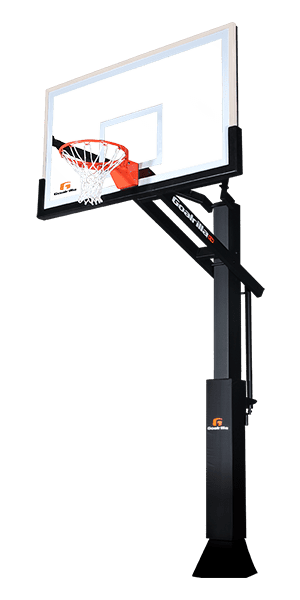
Installation Type: A semi-portable hoop with a separate anchor is your best choice. A portable goal is also an option if in-ground mounting isn’t possible.
Rim: Breakaway or flex rims are the way to go, as they flex under pressure. Make sure the rim is regulation-size 18 inches in diameter.
Backboard Size: 60” backboards are the most popular. 72”x42” is regulation size. 54” hoops are great for smaller driveways.
Backboard Material: Acrylic or tempered glass are ideal for outdoor use. Tempered glass provides the most rigidity and consistent rebounding (this is used in professional settings).
Height Adjustability: look for a goal that can be easily adjusted (but not lower than the ASTM standard pf 7.5’)
Choosing the Right Basketball Hoop to Buy
If selecting the right basketball hoop seems like an overwhelming task, don’t panic! We’re here to help. The experts at BasketballGoalStore.com are standing by to answer all your questions about what to look for when looking for purchasing a basketball hoop. We carry the full line of Goalrilla and Goalsetter basketball hoops so we’ve got something for everyone. Give us a call or chat now (if it’s after hours, leave us a message and we’ll get back to you as soon as we can) and let us know how we can help.
 Best Price Guarantee
Best Price Guarantee











